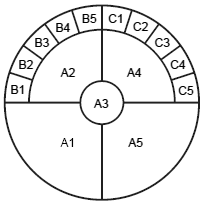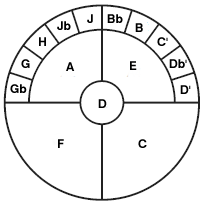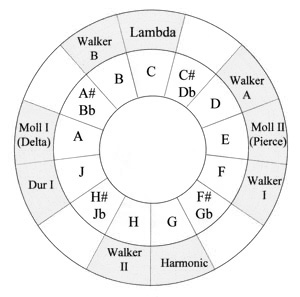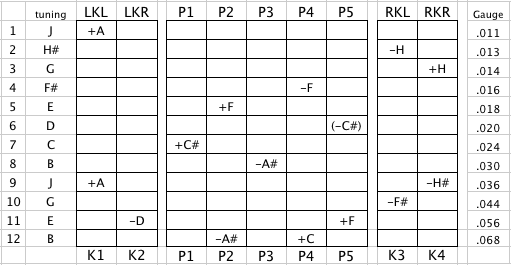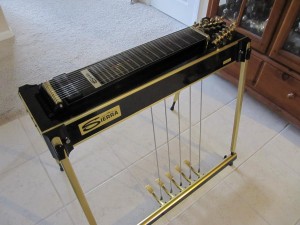The Bohlen-Pierce (BP) scale is an alternative musical scale arrived at by dividing the harmonic twelfth (a 3:1 frequency ratio) into thirteen steps. The result is an unusual sequence of tones providing many consonant intervals and hence the promise of extensive musical possibilities to those willing to explore non-traditional sounds.
While the mathematics of the BP scale have been analyzed in some depth over the last thirty years or so, so far the body of music created on this basis is still small, and the field is wide open to exploration by composers.
Though both just and equal tempered BP scales have been postulated, the equal tempered version would normally be chosen for tuning instruments of fixed pitch. As with the conventional scale, when playing instruments of variable or partially variable pitch, notes are tempered by the player in order to bring intervals and chords into tune in a particular situation.
Each equal tempered Bohlen-Pierce scale step has a frequency ratio of the 13th root of 3, or approximately 1.088, corresponding to roughly 146 cents on the conventional 12 tone scale. Consonant BP intervals are mostly based on odd number ratios: 3:1, 5:3, 7:3, 7:5, 9:5, etc. Some of these intervals (3:1 = perfect twelfth, 5:3 = just major sixth, 6:5 = minor third, etc.) are familiar, while others are not heard, or at least not recognized as consonances, in conventional Western music. The octave (2:1) has no special status in this tuning system. Instead, the sequence repeats at 3:1, an octave plus a fifth. In BP terminology, this interval is called a tritave.
For present purposes, 440Hz (or 442Hz in some countries) has been chosen as the central reference pitch. On this basis, the pitches of the equal tempered Bohlen-Pierce scale, and their relation to the conventional 12 tone scale, are as given in the table below.
| Bohlen-Pierce Scale |
| frequency (Hz) |
conventional pitch |
BP note name |
|
|
|
16.3
17.7
19.3
21.0
22.9
24.9
27.1
29.4
32.0
34.9
37.9
41.3
44.9
48.9
53.2
57.9
63.0
68.6
74.6
81.2
88.3
96.1
104.6
113.8
123.9
134.8
146.7
159.6
173.7
189.0
205.7
223.8
243.5
265.0
288.4
313.8
341.5
371.6
404.3
440.0
478.8
521.0
567.0
617.0
671.4
730.6
795.0
865.1
941.4
1024.4
1114.7
1213.0
1320.0
1436.4
1563.1
1700.1
etc. |
C – 6¢
Db + 40¢
Eb – 13¢
E + 33¢
F# – 21¢
G + 26¢
A – 29¢
Bb + 18¢
C – 36¢
Db + 10¢
Eb – 39¢
E + 4¢
F + 50¢
G – 4¢
Ab + 42¢
Bb – 11¢
B + 35¢
C# – 19¢
D + 28¢
E – 27¢
F + 20¢
G – 34¢
Ab + 12¢
Bb – 41¢
B + 6¢
C# – 48¢
D – 2¢
Eb + 44¢
F – 9¢
F# + 37¢
Ab – 17¢
A + 30¢
B – 25¢
C + 22¢
D – 32¢
Eb + 14¢
F – 39¢
F# + 7¢
Ab – 47¢
A
Bb + 46
C – 7¢
C# + 39¢
Eb – 15¢
E + 32¢
F# – 22¢
G + 24¢
A – 30¢
Bb + 17¢
C – 37¢
C# + 9¢
Eb – 44¢
E + 2¢
F + 48¢
G – 5¢
Ab + 40¢
etc. |
A (0)
A# or Bb
B
C
C# or Db
D
E
F
F# or Gb
G
H
H# or Jb
J
A (1)
A# or Bb
B
C
C# or Db
D
E
F
F# or Gb
G
H
H# or Jb
J
A (2)
A# or Bb
B
C
C# or Db
D
E
F
F# or Gb
G
H
H# or Jb
J
A (3)
A# or Bb
B
C
C# or Db
D
E
F
F# or Gb
G
H
H# or Jb
J
A (4)
A# or Bb
B
C
etc. |
Like this:
Like Loading...
